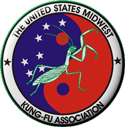Hsing I
Hsing I Chuan (Xing Yi Chuan)
Hsing I Chuan, or "Form Mind Boxing" is one of three main internal styles of Chinese Kung Fu which include Ba Gua Chuan, Tai Chi Chuan and Hsing I Chuan. Hsing I (XINGYI) is known for its direct and linear style which emphasizes simultaneous blocking and attacking. As an internal style, Hsing I utilizes deep meditative breathing and chi development to support its rapid striking and blocking techniques. Thus, there is a strong attention to posture, position, balance and coordinated breath. Song's Kung-fu Academy teaches the Five Elements style of Hsing I Chuan as well as a portion of the Twelve Animal System.
Hsing I Chuan is said to have roots back to the 12th century Song Dynasty, but there is little evidence to document this lineage. Some have speculated the origins of Hsing I Chuan to be from Spear techniques that were then developed into bare hand movements.
"...wrote the Preface to Six Harmonies Boxing in the 15th reign year of the Qianlong Emperor [1750]. Inside it says, '...when [Yue Fei] was a child, he received special instructions from Zhou Tong. Extremely skilled in spearfighting, he used the spear to create fist techniques and established a skill called Yi Quan [意拳]. Meticulous and unfathomable, this technique far outstripped ancient ones."
After Yue Fei's death, the art was lost for half a millennium. Then, during the Ming and Qing Dynasties in Shaanxi Province's Zhongnan Mountains, Yue Fei's boxing manual was discovered by Ji Longfeng (also known as Ji Jike) of neighbouring Shanxi Province. The earliest written records of Xingyiquan can be traced to the 18th century to Ma Xueli of Henan Province and Dai Longbang of Shanxi Province. Regardless of origin, Hsing I Chuan is a powerful and fascinating form of self-defense, spiritual development, health and exercise.
The Five Elements
Hsing I Chuan uses the five classical elements of Chinese Cosmology as a framework for it's fighting system. Metal, Water, Wood, Fire and Earth represent the five basic techniques that make up Hsing I Chuan's "Five Elements" system. Each element correlates to a separate movement and striking and blocking technique. Once these elements are pieced together, the five elements combination form creates a set of movements or series of combat techniques. There are single person forms, two person forms as well as meditative practice and combat application techniques.
| The Five Elements of Xingyiquan | ||||
| Chinese | Pinyin | |||
| Splitting | 劈 | Pī | Metal | Like an axe chopping up and over. |
| Pounding | 炮 | Pào | Fire | Exploding outward like a cannon while blocking. |
| Drilling | 鑽 | Zuān | Water | Drilling forward horizontally like a geyser. |
| Crossing | 橫 | Héng | Earth | Crossing across the line of attack while turning over. |
| Crushing | 崩 | Bēng | Wood | Arrows constantly exploding forward. |
The Animal Forms
Hsing I Chuan has animal forms represented in most styles and lineages. As in many of the Shaolin styles, the animal forms are taken from nature and many of the movements actually mimic the movements of the forms name. Some styles utilize very few movements from each animal. However, once these movements are learned, there is usually a linking form which connects the animal patterns into a sequence of movements for fighting application.
| The Ten Common Animals | |||
| Chinese | Pinyin | ||
| Bear | 熊 | Xióng | In Xingyi, "the Bear and Eagle combine," meaning that the Bear and Eagle techniques are often used in conjunction with each other. There is a bird called the "Bear Eagle" which covers the characteristics of both forms. |
| Eagle | 鷹 | Yīng | |
| Snake | 蛇 | Shé | Includes both Constrictor and Viper styles. |
| Tiger | 虎 | Hǔ | features lunging open handed attacks mimicking the pounce of a tiger |
| Dragon | 龍 | Lóng | The only "mythical" animal taught. in some styles it is practised separately from tiger because they are said to clash. |
| Chicken | 鷄 | Jī | mimmicks the pecking movement of a chicken |
| Horse | 馬 | Mǎ | uses left to right movements similar to the tiger form but with closed fists. mimicks the action of a rearing and striking horse |
| Swallow | 燕 | Yàn | Follows the swift and random movements of the swallow by rotating position and circling the enemy with strong but quick foot movement. |
| Goshawk | 鷂 | Yào | This can mean 'Sparrowhawk,' though the more common word for "Sparrowhawk" used to be Zhān (鸇), which has fallen from use over the years. |
| Monkey | 猴 | Hóu | |
Hsing I Weapons
Common weapons in Hsing I include the Spear, Strait Sword, Sabre, Large Sabre and Staff. As with the empty hand forms, a strong attention to posture, balance and internal energy is a focus of weapons work in Hsing I Chuan. Songs Kung Fu Academy teaches Hsing I weapons forms as well as combat techniques.
Song's Kung Fu Academy teaches Hsing-I Chuan to its advanced internal style students.
